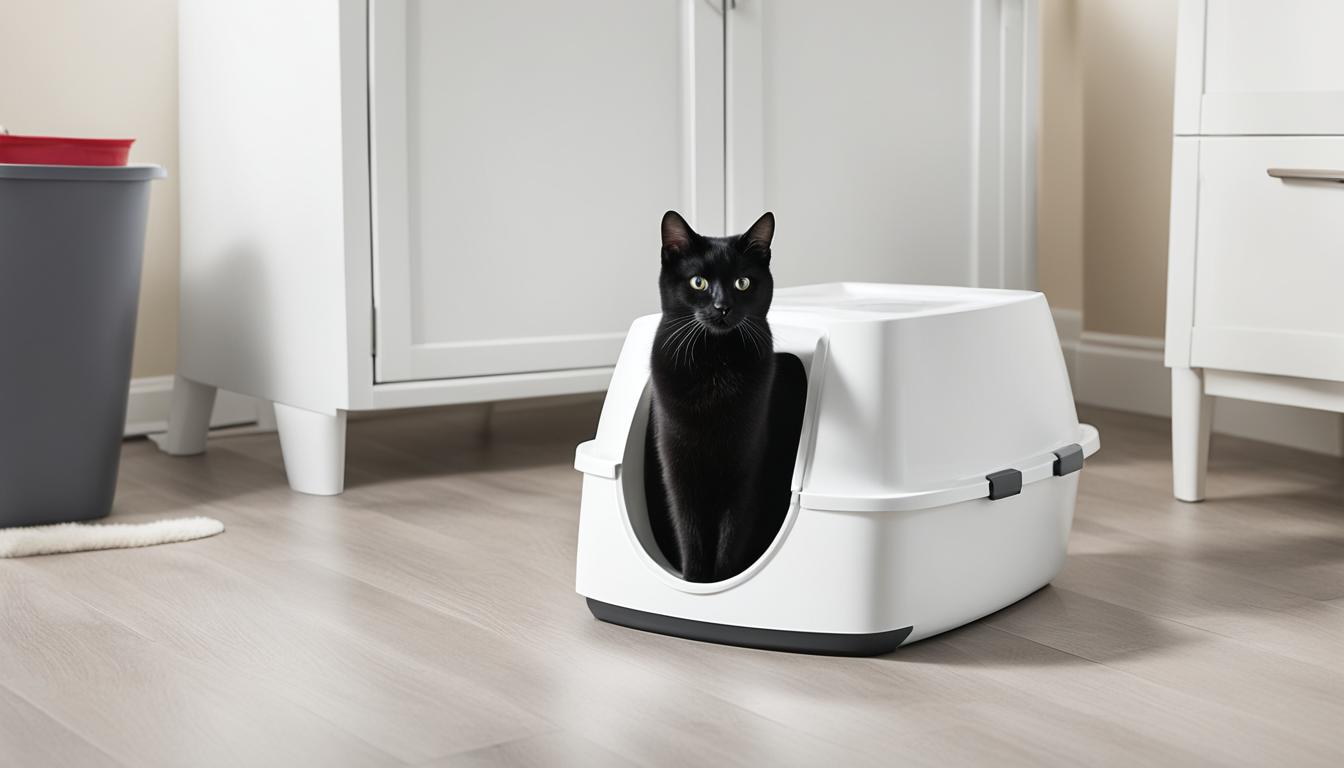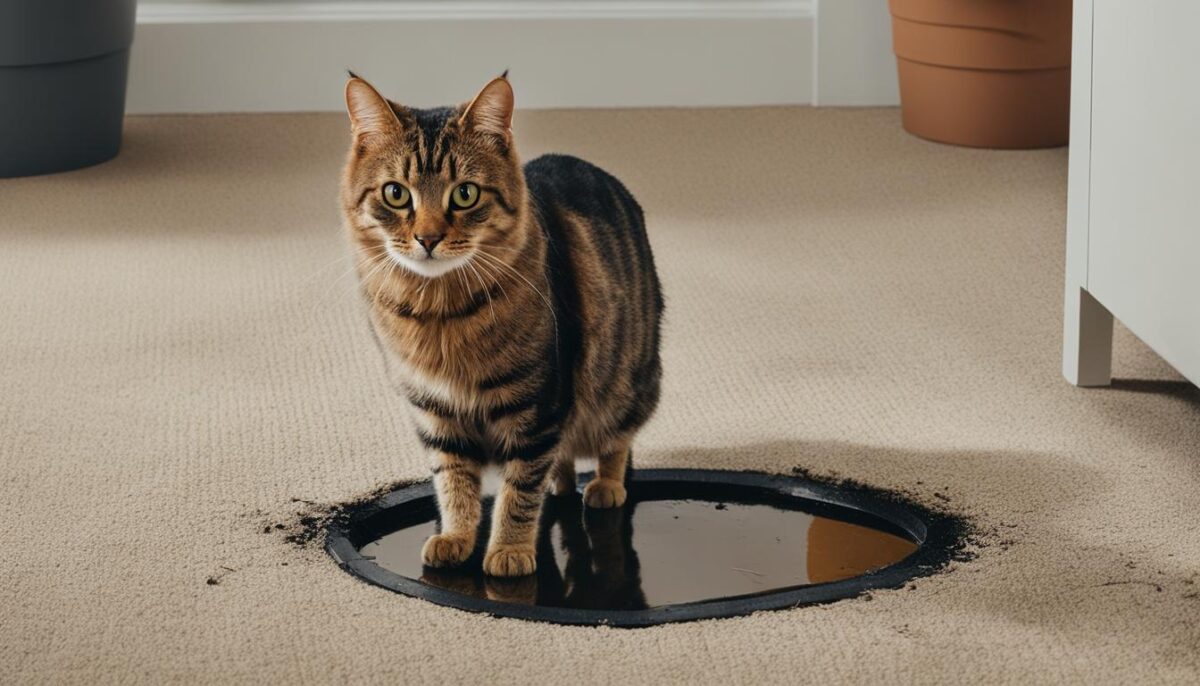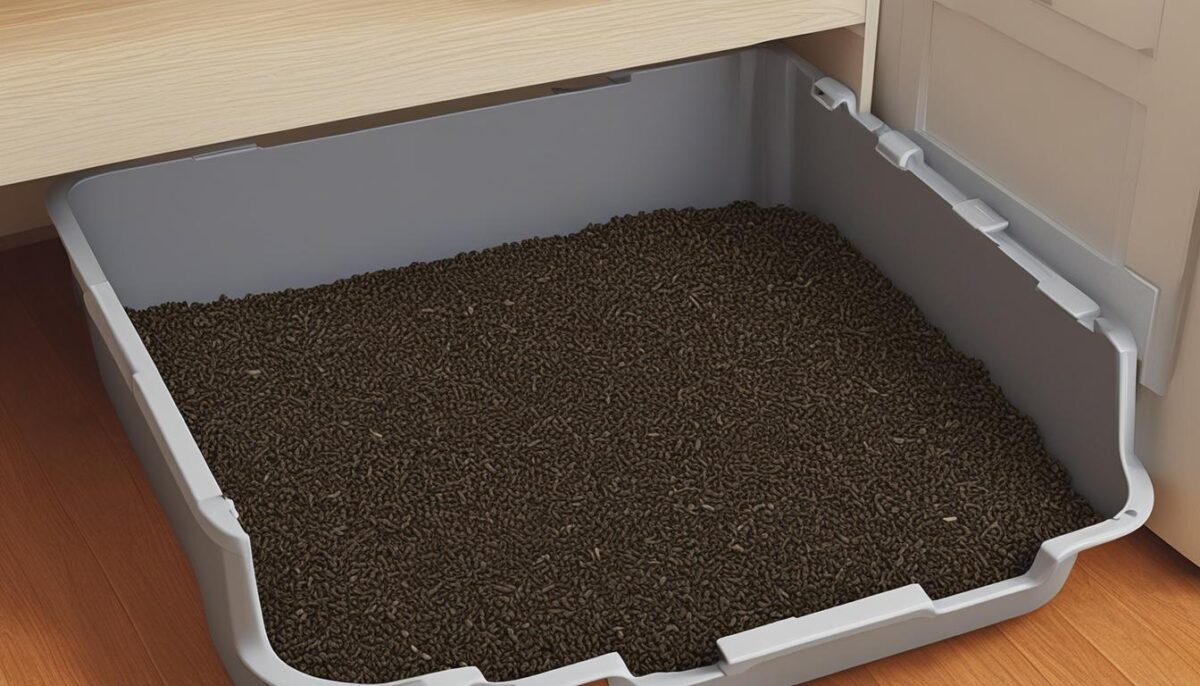Are you scratching your head trying to figure out how to stop cat peeing in your home? You’re not alone. Sometimes, cats do something called feline inappropriate elimination – this means they choose not to use their litter boxes. It can be really annoying, we know. They might even spray walls, letting everyone know, “Hey, this is my spot!” But other times, they might be avoiding their boxes because it hurts when they try to go. Or, maybe their box is just too hard to reach for them.
If your furry friend keeps avoiding the litter box, they may need a little help getting back to using it correctly. This could be true even if they are feeling better after being unwell. It’s possible they just don’t like their litter or the box itself, or they could be feeling nervous about something. Don’t worry, we’re here to help you solve this and prevent cat urination in your house!
Key Takeaways
- To prevent cat urination in house, check if they like their litter and box.
- If there are litter box issues, the box may be too dirty or in a bad spot.
- Understanding feline inappropriate elimination can help you find a fix.
- Be kind and patient to help your cat get back to using the litter box properly.
- Watching for when and where your cat sprays or pees can give helpful clues.
- Remember, if your cat is peeing out of place, they might be telling you they need help.
Understanding Inappropriate Urination in Cats
When your cat doesn’t use the litter box, it can be a big headache. Let’s dive into what causes these bathroom blunders and how you can help your furry friend.
Defining Feline Inappropriate Elimination
Ever find a surprise puddle from your cat somewhere that’s not the litter box? That’s what experts call feline inappropriate elimination. It’s a fancy term for when cats pee or poop where they’re not supposed to. And it’s actually one of the top reasons cats are brought to the vet or, sadly, given up by their owners.
Recognizing the Difference Between Spraying and Urination
There are two ways cats might go outside the box: urination and spraying. Cat spraying vs urination – yes, there’s a difference! When a cat sprays, they stand up, lift their tail, and spray a bit of pee on a wall or furniture. It’s a way of saying, “I was here!” or “This is mine!” Simple peeing, on the other hand, happens when they squat and leave more pee in one spot. It’s usually because they need to go and not for leaving a message.
Contributing Medical Issues to House Soiling
Why is your cat peeing outside the box? Sometimes it’s a sign of urinary tract diseases in cats. They could have bladder stones, infections, or other ouchies that make it hurt to pee. When it hurts, they may not want to jump into the litter box or be too late getting there. Drinking more water and extra trips to the bathroom are also clues that something’s up with their health.
If you’re facing cat urination problems, it’s important to visit the vet. The vet can help figure out what’s wrong and how to make your kitty comfortable and happy again. And when your cat feels better, those pesky pee problems often get better too!
The Link Between Feline Stress and Urination Issues
Have you noticed your cat is peeing outside of its litter box? This might be because your furry friend feels stressed. Cats can get worried by things like a new pet in the house, or something as small as a change in their litter. When they feel this stress, it can lead to stress-related peeing.
It’s not just about where they pee, but how they’re feeling. Your cat might not go in their box because they want to be alone or they do not feel safe. Think about it, when you’re scared, you want to find a place where you feel okay, right? It’s the same for cats. Plus, if they don’t like their litter, they might try something else that feels better on their paws.
When our kitties are stressed, they might pee more often, or in places where they can hide it. Cats like their privacy, and when they’re anxious, they really don’t like to be bothered. By finding out what’s making your cat unhappy and fixing it, you can help stop the behavioral issues in cats like peeing where they shouldn’t.
- Look for changes in the house that might stress your cat.
- Make sure the litter box feels safe.
- Try different types of litter to see which one your cat likes.
Remember to give your cat lots of love and a quiet space. This helps them feel less worried about stuff. With care and patience, you can help your cat feel better and say goodbye to those pesky pee problems!
How to Stop a Cat from Peeing in the House
When your furry friend starts using the house as a bathroom, it can be a big problem. Let’s fix that together! First things first, we need to make sure your cat feels good. If they’re sick, it can make them pee in places they shouldn’t. A vet can help find out if they’re healthy. Now, if your cat is okay, it’s time for some changes to stop the pee problems.
Importance of Medical Examination
It’s super important to make sure your cat isn’t sick. If peeing hurts, they won’t want to use the litter box. So, a trip to the vet is the first step to help your cat.
Positive Reinforcement and Behavior Modification
Did you know that you can teach your cat to do things with treats and love? When they use the litter box, giving them a yummy snack and being super nice to them makes them think, “Hey, this is a good thing to do!”
Environmental Adjustments for Your Cat
Your cat’s space is super important to them. Make sure their litter box is clean and in a spot they like. Cats love a quiet place that lets them see everything, so pick a great spot in your home.
Here’s a cool tip: If you have lots of cats, more boxes might help keep the peace. Think about it like having enough bathrooms for everyone. To remember all this, check out the helpful table below!
| What to Check | Why It’s Important | What to Do |
|---|---|---|
| Health Check | To make sure there’s no ouchie when they pee | Visit the vet |
| Litter Box Love | Cats won’t go where they don’t like | Keep it clean and cozy |
| Treats and Cuddles | Makes using the litter box something they want to do again and again | Give rewards when they get it right |
| Quiet Spot | They need to feel safe and see all around | Find a peaceful place for the box |
Identifying Behavioral Factors Contributing to Litter Box Aversion
When it comes to cat litter box avoidance, it’s like a puzzle. There could be many reasons why your furry friend is saying “no thanks” to their litter box. Imagine if you had a place where you felt uneasy or reminded you of a bad time – you wouldn’t want to go there either, right? Well, cats feel the same way. They might have had a moment when it hurt to go potty, and now their litter box scares them.
Also, think about how you cherish your privacy and quiet time. Cats do too! If their box is in a spot that’s busy or loud, your cat might be thinking it’s not the chill restroom spot they long for. They have litter box preferences, much like how you might choose your favorite chair. Cats absolutely love consistency – if something changes at home, even slightly, it can really ruffle their fur. They might just avoid their box because they’re not feeling those good, safe vibes anymore.
Lastly, let’s chat about cat litter aversion. If your cat isn’t keen on digging and burying their business in the current litter, it’s time for a change. Think like a cat for a moment – they are neat and tidy creatures that take pride in covering up after themselves. If the litter isn’t right for their little paws, they’re going to find somewhere else that suits them better. So, take a moment to see if you can make their litter box experience a happy one, and you might just solve the mystery of the unwanted puddles.
FAQ
What is feline inappropriate elimination?
Feline inappropriate elimination is when your cat pees or poops outside of their designated litter box. It’s a common problem and can be a sign of stress, medical issues, or dissatisfaction with their litter box setup.
How can I distinguish if my cat is spraying or just not using the litter box properly?
If your cat is spraying, they will typically stand up and release a small amount of urine on vertical surfaces mainly to mark their territory. In contrast, inappropriate urination usually involves larger amounts of urine deposited on horizontal surfaces.
Could my cat’s in-house urination be a sign of a medical condition?
Yes, several medical conditions such as urinary tract infections, bladder stones, or other urinary tract diseases in cats could cause them to urinate outside their litter box. It’s crucial to have your cat examined by a vet to rule out health problems.
What are some stress-related reasons my cat may be peeing outside their litter box?
Stress-related peeing can occur due to numerous factors, such as changes in the household, new pets or people, changes to their routine, or issues with the location or type of their litter box.
How can I stop my cat from peeing in the house?
First, visit your vet to eliminate the possibility of medical issues. Then you can use positive behavior techniques for cats, such as consistency with litter box training, environmental adjustments, and positive reinforcement when they use their litter box properly.
What if my cat seems to have a litter box aversion?
Litter box aversion can be caused by various factors, including the type of litter, the cleanliness of the box, its location, or negative associations. Observing your cat’s preferences and making adjustments accordingly can help address this issue.
Can behavioral issues in cats lead to inappropriate urination, and how can I address them?
Yes, behavioral issues such as anxiety, territorial marking, or conflicts with other pets can lead to inappropriate urination. Addressing the root cause of stress, providing adequate resources, and maintaining a clean and comfortable litter area are important steps in resolving these issues.
Why might my cat not like their litter box, and what should I do?
Cats may dislike their litter box if it’s too small, covered, placed in a high-traffic area, or if the litter is uncomfortable for them. Try different types of boxes and litters to see what your cat prefers, and ensure it’s kept clean and placed in a quiet, accessible spot.


